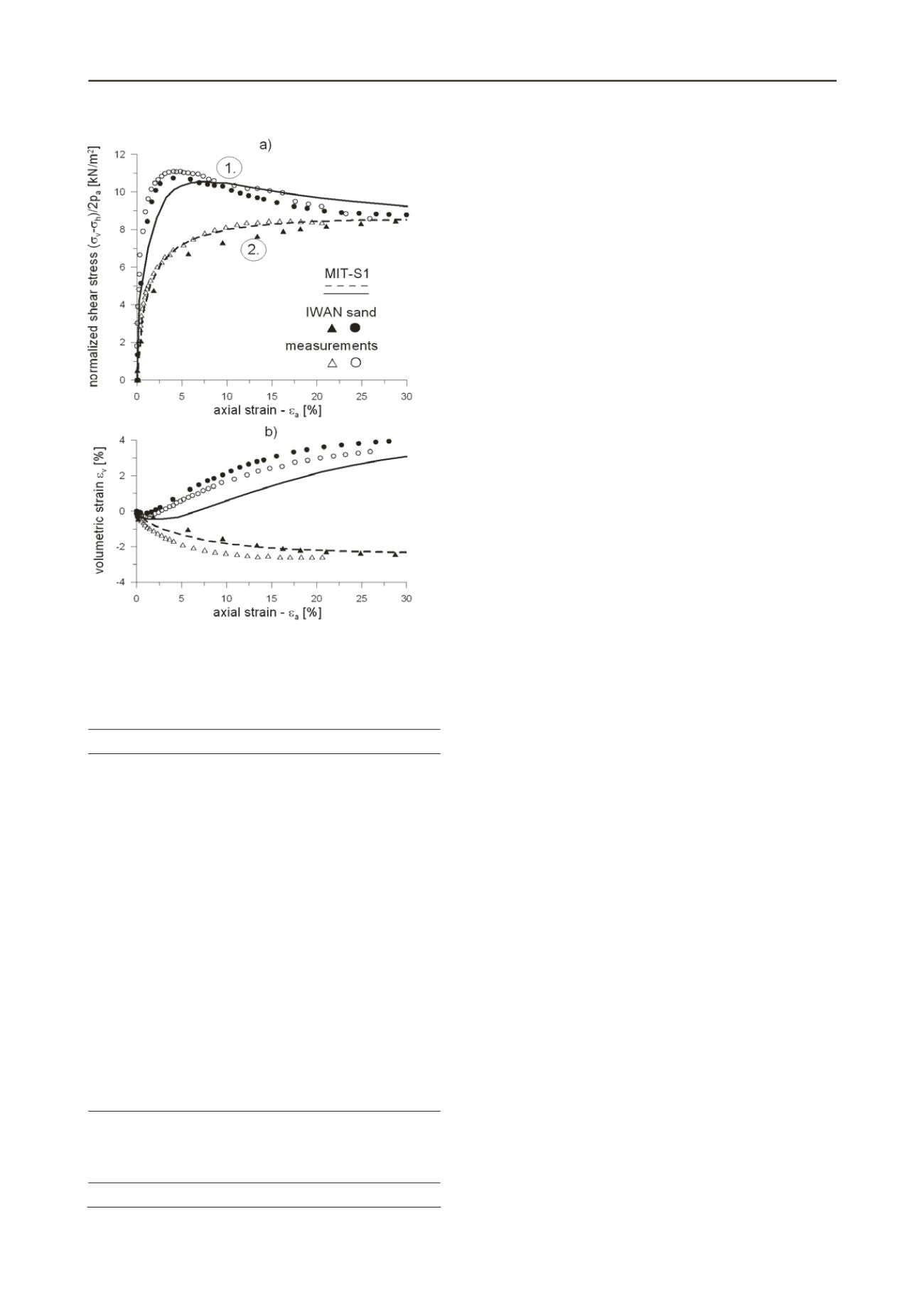
811
Technical Committee 103 /
Comité technique 103
Figure 3. Comparison of predicted and measured results of CID triaxial
test for danse and loose sample of Berlin sand
Table 1. Iwan sand model parameters. (
a)
material parameters for Berlin
sand;
b)
initial state parameters;
c)
Iwan system parameters;
*
adopted
rom Iwan model calibration – Sokolić, 2010)
f
Parameter [unit]
symbol
value
a)
Minimum void ratio
e
min
0.389
a)
Fiction angle for critical state [
o
]
φ
cv
31
a)
Peak strength parameter
k
M
1.3
a)
Initial shear stiffness parameter [kPa]
A
67.000
a)
Power exponent for stiffness
m
0.33
a)
Poisson’s ratio
0
*
a)
Critical state line
2.35
s
c
3544
0.385
a)
Shear backbone curve
b
0.03
*
a
1
0.16
*
a
2
0.60
*
a)
Dilatancy
d
1
2.0
*
d
2
-0.5
*
a)
Compression backbone curve
v
28
b)
Initial void ratio
e
0
0.4 – 0.6
b)
Over consolidation ratio
OCR
1.0
b)
K
0
for normal consolidation
K
0
NC
0.5
c)
Limit strains (20 elements) [%]
u
i
y
0.01 - 50
Critical state line (CSL) is defined by the following expression
proposed by Sheng et. al. (2008):
ref
c
cv
pp s
e
/'
/
(2)
The parameters are derived to best fit the CSL line adopted for
MIT-S1 soil model (
= 2.35,
s
c
= 3544,
= 0.385;
p
ref
= 100
kPa). The value of CSL line for ‘zero’ isotropic pressure defines
the material parameter
e
cv0
= 0.60 (Figure 2.a).
Shear strength is defined by following expressions (similar to
concept proposed by Jeffries and Been 2006):
sM cv
C
IkMM
(3)
where
M
C
is the peak strength ratio for drained triaxial test
(
M
c
=
q
p
/
p
p
’;
q
p
– peak deviator stress;
p
p
’ – effective isotropic
pressure at peak strength);
M
cv
is the strength ratio for critical
state of sand (
M
cv
= 6sin(
φ
cv
)/[3-sin(
φ
cv
)];
φ
cv
= 31
o
– friction
angle for critical state taken from results of triaxial tests). Peak
strength parameter
k
M
= 1.3 is calibrated by numerical
simulations of CID test and by comparing the results to the
available measurements (Figure 3.a).
Initial shear stiffness of the sand
G
0
is defined by following
expression (proposed by Pestana and Salvati 2006):
m
ref
pp Ae G
/'
3.1
0
(4)
where
m
= 0.33 is power index accepted as proposed for
MIT-S1 soil model, and
A
= 67.000 kPa is initial shear stiffness
parameter derived to best fit the initial stiffness profile proposed
for MIT-S1 numerical simulation.
Backbone curve for isotropic compression is defined by
following expression (hyperbola):
v
v
e
v
v
1/
(5)
where
v
e
is elastic component of volumetric strain,
v
is natural
volumetric strain and
v
= 28 is material parameter for sand
compression derived as best fit approximation of isotropic test
results (Figure 2.b). The odometer tests performed on Berlin
sand are interpreted as isotropic compression tests by using
K
0
value according to Jaky’s correlation
K
0
= 1– sin
φ
= 0.5.
All remaining material parameters are adopted from model
calibration preformed on different types of sand (Erksak,
Otawa, Ticino, Toyoura, Boštanja, Cambria). Parameters are
used for backbone curve of triaxial shearing (double hyperbola
function similar to stiffness reduction curve proposed by Fahey
and Carter 1993) and stress dependent dilatancy function
(integrated function as combination of expressions proposed by
Li and Dafalias 2000, and Gutierrez 2003).
Input parameters for Iwan system are also adopted from model
calibration (number of spring-slider elements
n
Iw
= 20; limit
displacements for shearing and compression for each element
spanning evenly the range of strains 0.01% to 50% in
logarithmic scale).
4
NUMERICAL ANALYSIS
Numerical analysis of deep excavation are performed within the
commercial finite-element program Plaxis 2D (Brinkgrawe,
2008). The geometry and boundary conditions of the model are
adopted from the numerical analysis performed by the advanced
model MIT-S1 (Nikolinakou, 2011). Two wall sections were
analyzed (MQ3 and MQ5). Soil profile is modeled by three
horizontal soil layers with underground water level 2 m below
the surface level.


